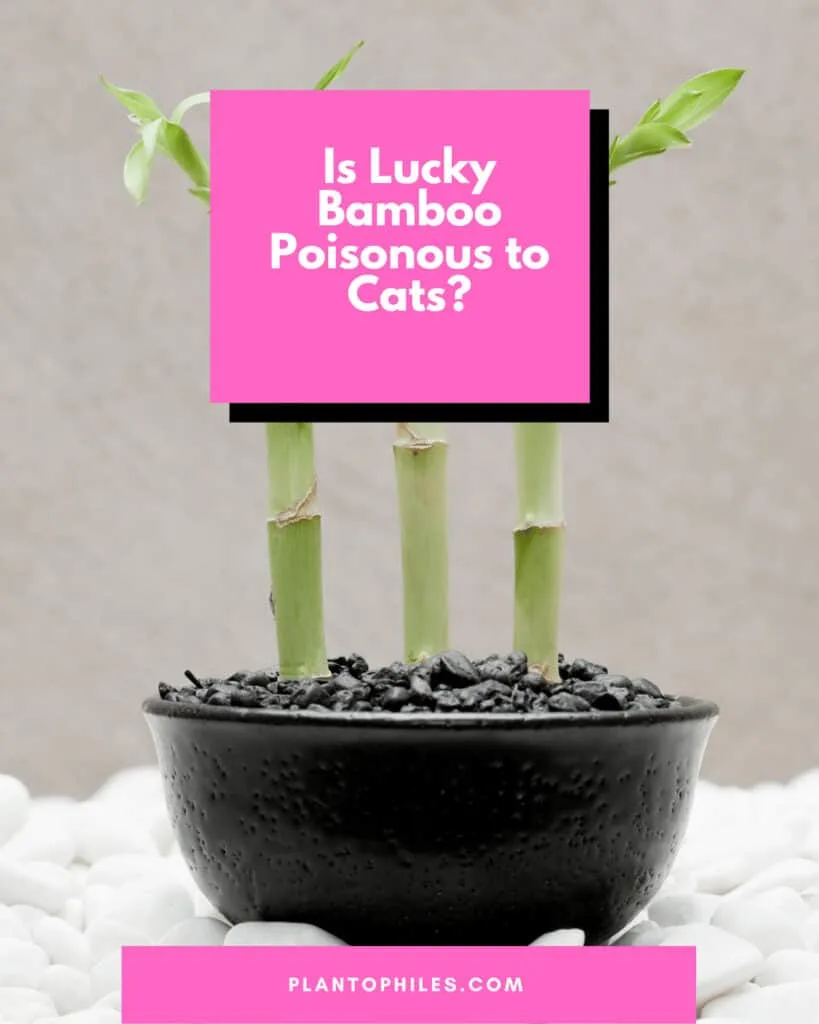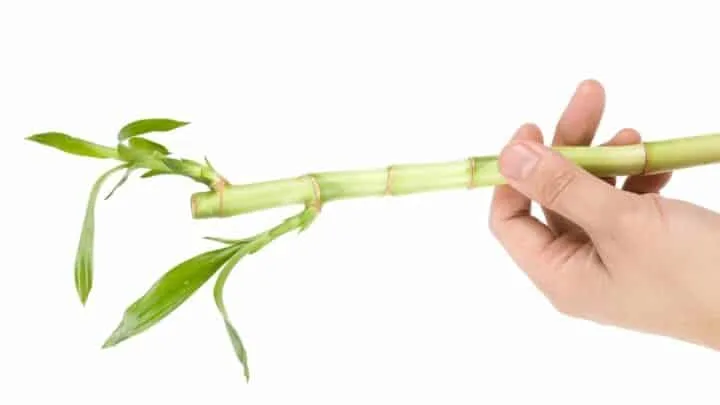Is lucky bamboo poisonous to cats? Lucky bamboo (Dracaena sanderiana) is not precisely bamboo but a tropical water lily.
If you’re hesitant to continue with your plans to buy a lucky bamboo because you have pets at home, keep reading and find out how lucky bamboo can affect your feline pal.
Table of Contents
Is Lucky Bamboo Poisonous to Cats?
Lucky bamboo is poisonous to cats. You always want to ensure your lucky bamboo plant is out of reach. An alternative way is to ensure cats are repelled by it to keep them safe.

Is Bamboo Toxic to Cats?
Real bamboo from the subfamily Bambusoideae is not toxic to cats, dogs, and other animals. Bamboo belongs to the Poaceae family of plants. The plants you buy as sticks with a couple of leaves are called lucky bamboo and do not belong to the same plant family.
Signs and Symptoms Your Cat Has Ingested Lucky Bamboo
Indeed, we cannot control where our feline pals roam around in our house. But we can prevent cats from getting in contact with our lucky bamboo.
But what if your feline accidentally ingested lucky bamboo, and you’re not sure how lucky bamboo poisoning presents.
Here’s what you should take note of:
Diarrhea
Stools are unformed to fluid.
Upset Stomach & Nauseous
If your cat starts licking its lips and swallowing hard, this is a sign of nausea.
Vomiting
No need to explain this; we all know what it is.
Lack of Appetite
If your cat is no longer interested in eating, it could indicate that they eat some of the lucky bamboo.
Drooling
This is a common sign when a cat has ingested lucky bamboo. Their saliva glands seem to go into overdrive.
Loss of Coordination
If your cat seems to be stumbling or leaning to one side, this is a sign of a problem.
They may also fall when walking because their legs are unbalanced, and they also look for any changes in their behavior.
Dilated Pupils
Check your cat’s eyes for large pupils (the black spot in the center of the eye). This is almost a sure sign your cat eats some lucky bamboo.
Increased Heart Rate
Cats have a resting heart rate of about 120 to 140. If their heart rate is higher, bring them to a veterinarian ASAP.
Not only is this a sign of ingesting lucky bamboo, but it is also a sign of a problem that needs to be checked out.
Immediate Treatment
You need to recognize any of the signs and symptoms above.
If you notice any of these signs or more than one, you should contact your vet and tell them your cat may have ingested lucky bamboo.
Depending on the signs and symptoms, they may have you watch your cat and see if it gets worse or if any new signs or symptoms appear.
If your cat worsens, bring them to an emergency vet’s office or an animal hospital.
Lucky Bamboo Poisoning Treatment
Before you attempt to treat your cat for lucky bamboo poisoning, try to make sure your cat ingested it. Look closely at the plant to see if any leaves are missing, bite or scratch marks, etc.
It may take up to six to twelve hours before your cat starts showing any signs or symptoms of ingesting the lucky bamboo, so if you suspect they did but do not have proof (the best proof is to see them eating it), wait before treating them and see if they develop any signs or symptoms.
Wait for at least 6 to 12 hours to see if anything happens.
If your cat shows signs of lucky bamboo poisoning, the veterinarian can safely try the methods below.
Gastric Lavage
This helps by pushing the stomach contents (the lucky bamboo) out. It must be started within two hours after ingestion.
This would be the case if you visually saw your feline eating the lucky bamboo.
A tube is inserted to protect your cat’s airway, and its stomach contents are purged from the stomach.
Your cat is under general anesthesia for this procedure and usually requires a few days in the animal hospital or vet’s office for observation.
IV Therapy
Fluids are pushed through the cat’s body to keep them hydrated and try to prevent kidney damage.
Your cat will likely not feel like drinking; it may not stay down if they do.
How to Prevent Your Cats from Ingesting the Lucky Bamboo
Try using something like vinegar because of its strong odor. Vinegar is commonly used, although it can be harmful to the plant.
To keep your cats away from plants, you may use various home substances or fragrant items that the smell repels your cat. It is an easy and effective way to keep your pet safe.
The more the repellent stinks, the better. There is a list of things you can try.
Make a Garlic Paste
Get real garlic cloves and mince them. Pour a little water and mix them until it’s pasty.
Put the paste near but not on because it will damage the lucky bamboo.
Chili Powder or Hot Pepper Flakes
Put the plant on a cloth, vinyl placemat, or another decorated item that can be easily washed. Sprinkle the powder or the flakes around the plant.
This should keep your cat away.
Strong Soaps
There are a lot of strong-smelling soaps on the market. Some are common and used daily, such as Irish Spring.
Use a cheese grater, grate some of the soap off the bar, and sprinkle this around the plant just like chili powder or red pepper flakes.
Cat Plants
Pet stores sell a large assortment of leafy plants that are made for cats. If your cat has its plant(s), they are likelier to leave the lucky bamboo alone.
Some of the choices you have to include the following:
- Catnip
- Valerian
- Mint
- Licorice Root
- Cat Grass
- Lemongrass
- Cat Thyme
Lucky Bamboo Hanging Baskets
Instead of setting your Lucky Bamboo plant on the coffee table or a stand where your cat can easily access it, try putting it in a decorative hanging basket.
You’ll be able to enjoy taking care of your lucky bamboo, and your cat won’t be able to reach it.
Hide the Plant
If your cat can’t see the plant, they are unlikely to want to investigate or nibble on it.
It seems like an easy solution, but remember, cats are very curious, so you must find a good hiding place.
Frequently Asked Questions about Lucky Bamboo being Poisonous to Cats
What part of the lucky bamboo plant is poisonous to cats?
The entire plant can make your cat very sick and, in rare incidents, be fatal.
If my cat only ate a little lucky bamboo, how long before she felt better?
Your feline should be up and about within 24 hours.
Conclusion
Several indoor and outdoor plants are toxic to cats. Do your best to prevent your feline pal from eating any plants. Provide them with healthy plants specially made for cats to keep them safe. Lucky bamboo is toxic to cats, whereas real Bamboo is non-toxic.

Daniel has been a plant enthusiast for over 20 years. He owns hundreds of houseplants and prepares for the chili growing seasons yearly with great anticipation. His favorite plants are plant species in the Araceae family, such as Monstera, Philodendron, and Anthurium. He also loves gardening and is growing hot peppers, tomatoes, and many more vegetables.


